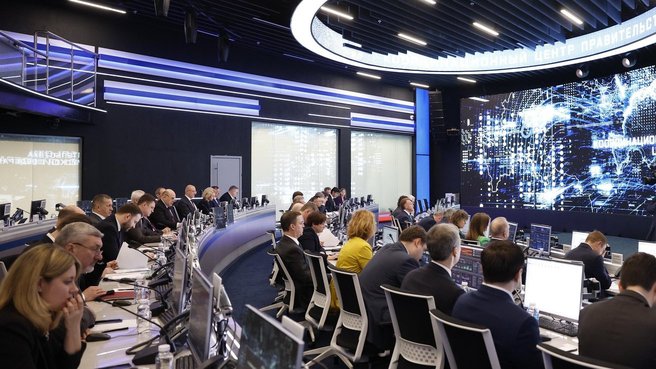Mikhail Mishustin: “The measures implemented by the Government in the previous year have borne fruit, evident in the GDP dynamics and the positive shifts across various sectors. In the beginning of 2024, this growth trajectory remains unchanged, underscoring the continued development of our economy. According to the Ministry of Economic Development, GDP grew by nearly 5 percent in January and by 7.7 percent in February.”
Mikhail Mishustin’s opening remarks:
Good afternoon, colleagues,
We continue our series of strategic sessions.
At the President’s instructions, we are spearheading the transition to a supply-side economy, geared towards establishing cutting-edge industrial capacities and sectors, particularly focusing on promising technologies.
Achieving this goal requires an overhaul of infrastructure and the enhancement of productive forces, alongside fostering a balanced labour market equipped with skilled personnel.
Our proactive policy in this regard needs to address several key systemic objectives outlined by the President. First of all, it is the attainment of technological and financial sovereignty and bolstering food security. Additionally, it is necessary to elevate Russia’s position in global trade, with a primary focus on non-raw material exports. These efforts are essential for meeting domestic demand and further enhancing the quality of life for our citizens.
The measures implemented by the Government in the previous year have borne fruit, evident in the GDP dynamics and the positive shifts across various sectors. We discussed them last week during the Government’s annual report in the State Duma. In the beginning of 2024, this growth trajectory remains unchanged, underscoring the continued development of our economy. According to the Ministry of Economic Development, GDP grew by nearly 5 percent in January and already by 7.7 percent in February.
The industry also grew by about 8.5 percent this past February. As in 2023, the processing industry is the main driving force, and it is posting record-breaking growth. In the second month of the year, the processing industry grew by 13.5 percent, the best monthly indicator in the past few years, to say the least.
Emerging demand for new Russian goods and services is facilitating these changes. Retail trade volumes highlight growing consumer activity. These volumes soared by over 12 percent in February, as compared to 9 percent in January. Unemployment hit an all-time low once again, totalling 2.8 percent.
We need to maintain these trends, primarily using the national development programme, set forth by the President in his Address to the Federal Assembly. Russia should join the four largest economies worldwide (in terms of purchasing power parity) by 2030.
We need to launch simultaneous proactive work in several fields. First of all, we should drastically expand investment volumes, primarily in capital-intensive sectors, and for projects facilitating technological and industrial sovereignty.
It is important that we transform the labour market; we should create a system that would facilitate more flexible personnel retraining projects in accordance with national economic requirements.
Additionally, we need to make the real economy more cost-effective. We have to continue boosting labour productivity. We have launched a specialised national project in this sphere, and it had involved almost 6,000 companies last year employing about 1.5 million people.
It is necessary to ensure the high-priority development of the infrastructure and to export more non-commodity and non-energy goods to the markets of friendly countries.
Today, we will review the specifications of a short-term hypothetical economic model in great detail, with due consideration for industry specifics. We will define macroeconomic conditions, key targets, as well as the main risks and measures for achieving the goal, set by the President.
We need to approve all essential measures in the near future for accomplishing objectives, set by the President.








